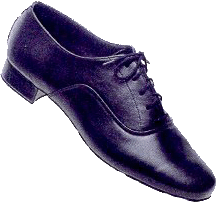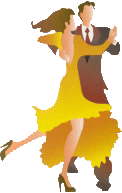
This essay has been reprinted with permission from the Colorado Round Dance Association.
 Round
Dancing is basically choreographed ballroom dancing with all
couples dancing the same figures around the floor at the same
time, similar to a formation dance team or to sequence dancing.
Over the last 50+ years thousands of routines have been
choreographed to match specific music in almost every dance style
imaginable. A routine done to a specific piece of music in
Colorado USA is almost always the same routine you would do to
that music in Japan or any other place worldwide at the same
level of difficulty.
Round
Dancing is basically choreographed ballroom dancing with all
couples dancing the same figures around the floor at the same
time, similar to a formation dance team or to sequence dancing.
Over the last 50+ years thousands of routines have been
choreographed to match specific music in almost every dance style
imaginable. A routine done to a specific piece of music in
Colorado USA is almost always the same routine you would do to
that music in Japan or any other place worldwide at the same
level of difficulty.
This formation team type of dancing eliminates the traffic jam feeling that you sometimes get while free form ballroom dancing. Dancers are able to concentrate more on how they are executing figures and dancing as one coherent unit as opposed to trying to think about which figure or pattern to do next.
 Dancers
rely on an instructor to guide them through the figures in each
routine, thereby eliminating the need to memorize. In an average
evening session a couple typically dances 20-60 different
routines.
Dancers
rely on an instructor to guide them through the figures in each
routine, thereby eliminating the need to memorize. In an average
evening session a couple typically dances 20-60 different
routines.
Another distinguishing characteristic of Round Dancing is the use of a "cuer". Since there are far too many routines to memorize, a cuer calls out the name of each figure in the routine just before it is to be executed. If you have a memory lapse or are unfamiliar with a particular routine or figure, you can continue progressing with the dance flow until you get to a spot or a figure that you recognize.
 Round
Dancers learn from day 1 to associate each foot pattern with the
figure name. This makes it easier to teach future routines since
the dancer has a repertoire of figures at their fingertips (okay
‘foottips’). The average dancer has a repertoire of
hundreds of routines and will typically dance 20-60 of these
routines during the average evening. Clubs and classes in
addition to putting on known routines will also typically teach
part or all of a new routine or work on figures each evening.
Round
Dancers learn from day 1 to associate each foot pattern with the
figure name. This makes it easier to teach future routines since
the dancer has a repertoire of figures at their fingertips (okay
‘foottips’). The average dancer has a repertoire of
hundreds of routines and will typically dance 20-60 of these
routines during the average evening. Clubs and classes in
addition to putting on known routines will also typically teach
part or all of a new routine or work on figures each evening.
This is not to say that Round Dancing is better than conventional ballroom. Rather, the two complement each other. Round Dancing helps you strengthen your basic repertoire of ballroom figures and permits you to do some figures that you would not dare to try at a conventional ballroom dance. We find that each type of dancing reinforces the other, and leads to greater enjoyment of dancing in general.
 There
are 6 levels of round dancing called phases. Phases 1 & 2 are
"easy level" and include 2-step (similar to a type of
country western dancing) and waltz (bronze figures - enough to
dance at your daughter's wedding & elsewhere, the basics).
Phase 3 & 4 are the intermediate levels (bronze & silver
figures) and include additional waltz figures in addition to
introductions to other rhythms in the International &
American styles. Rhythms include: foxtrot, quickstep (similar to
Arthur Murray foxtrot), international tango, American tango,
Argentine tango, cha, rumba, bolero, mambo, jive, swing, west
coast swing, samba, paso doble, slow two step (also called
night-club two step), & others. Phase 5 & 6 (gold, star,
& above figures) take dancers into the upper levels of
dancing, including most of the figures you see at ballroom
competitions. At the upper levels many of the Round Dance
instructors are trained by some of the best International &
American ballroom teachers/competitors in the world. Several
technique books & videotapes have been created by Round Dance
organizations and individuals around the world (For Example:
ICBDA (formerly known as
URDC), & Roundalab).
There
are 6 levels of round dancing called phases. Phases 1 & 2 are
"easy level" and include 2-step (similar to a type of
country western dancing) and waltz (bronze figures - enough to
dance at your daughter's wedding & elsewhere, the basics).
Phase 3 & 4 are the intermediate levels (bronze & silver
figures) and include additional waltz figures in addition to
introductions to other rhythms in the International &
American styles. Rhythms include: foxtrot, quickstep (similar to
Arthur Murray foxtrot), international tango, American tango,
Argentine tango, cha, rumba, bolero, mambo, jive, swing, west
coast swing, samba, paso doble, slow two step (also called
night-club two step), & others. Phase 5 & 6 (gold, star,
& above figures) take dancers into the upper levels of
dancing, including most of the figures you see at ballroom
competitions. At the upper levels many of the Round Dance
instructors are trained by some of the best International &
American ballroom teachers/competitors in the world. Several
technique books & videotapes have been created by Round Dance
organizations and individuals around the world (For Example:
ICBDA (formerly known as
URDC), & Roundalab).
Round dancing is good exercise and provides a relatively inexpensive evening's entertainment: the price for a typical club dance is about $7-$15 per couple for 1-1/2 to 3 hours. In addition, the social camaraderie should not be overlooked. Round Dancers tend to be extremely friendly, sociable, and very helpful people.
Links to more information on Round Dancing
For questions about WRDLC, or comments on this page, write the webmaster.